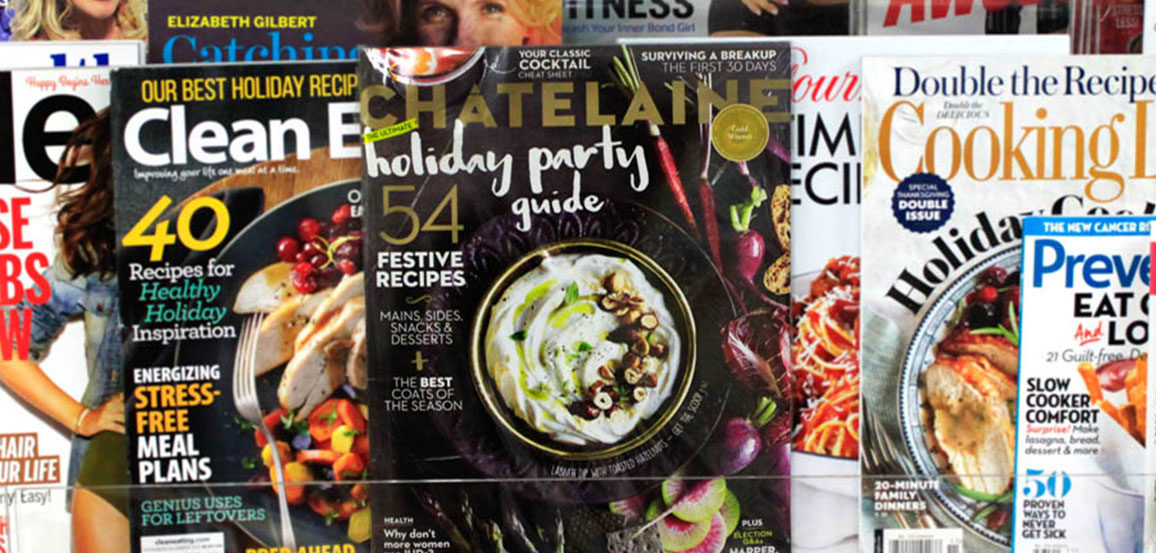Heather McIntosh was cleaning out her grandmother’s house when she found some pages from an old issue of Chatelaine that had been used to seal a painting into its frame. The University of Ottawa master’s student was captivated. McIntosh says while it’s easy to label the magazine as exclusively recipes and cosmetics, these pages from the late 1920s or early ʽ30s seemed radical for their time. McIntosh studied Chatelaine for her thesis and spent months in the National Archives poring over issues from 1928 to 2010. In past issues, advertisements for beauty and homecare products sat companionably beside recipes and how-to articles, in addition to lengthy features about serious issues. “The contradictions,” she says, “were just absolutely crazy.”
Those contradictions persist because Canadian women haven’t stopped wanting serious journalism in the mix. And that’s what Lianne George, Chatelaine’s sixth editor since 2004, wants to give them. A decade of high turnover has left observers wondering if the venerable title is still relevant, but George’s appointment comes at an ideal time: conversations about feminism are flourishing online, and she wants the magazine to join the fray.
Chatelaine is one of the most widely read Canadian magazines, with a paid circulation of almost 540,000 and a readership of 3.1 million. In the 1960s and ʽ70s, widely regarded as the magazine’s feminist heyday, editor Doris Anderson ran articles about controversial issues such as child abuse and still maintained the wide circulation, which meant the publisher Maclean-Hunter seldom questioned the magazine’s content. “As long as the magazine was selling, she could do whatever she wanted,” says Rona Maynard, who was editor from 1994 to 2004. “Those days are long gone.”
Maynard should know. She was editor through the magazine’s sale to Rogers Publishing, a notable revamp and the launch of Chatelaine’s first website. After she left, Rogers wasn’t sure what the magazine should be, and that uncertainty was reflected in the short tenures of a parade of editors. At the same time, thin margins meant there was little tolerance for anything less than magic and new editors, some of them with no editor-in-chief experience, were subject to Rogers’s shifting standards. The longest serving editor since Maynard was Jane Francisco, at just four years, who left for Good Housekeeping at the end of 2013. “Very beautiful service is Jane’s strong suit,” says Maynard, and her Chatelaine was beautiful and light. Her successor, Karine Ewart, stayed only 17 months before George succeeded her in June 2015.
Choosing George signals that Rogers finally has a clear vision for Chatelaine. With a career that includes Maclean’s, Canadian Business and most recently Toronto alt-weekly The Grid, she is a strong choice for editor. Although she hasn’t finalized her plans yet, they clearly don’t centre around “beautiful service.” The magazine will continue with its blend of content, but George says it’s a living thing and readers can expect it to evolve: “Chatelaine has been around for almost 90 years, and it’s served a lot of purposes over the decades—domestic bible, community hub and under Doris Anderson it led the charge on a lot of women’s rights issues.”
Now George wants it to join today’s conversation about women’s issues. One of her recent moves was hiring Sarah Boesveld from the National Post, where she was known for her sharp takes on the issues of the day across platforms, as well as her thoughtful features in the paper. George wanted her newsy approach for the online site, but Boesveld is also looking forward to doing longer pieces for the print magazine.
Although George is clearly working on a politically engaged Chatelaine, some readers may not be ready. Carol Toller’s 2,500-word profile of Justin Trudeau in October 2014, for example, generated a lot of criticism. Post columnist Robyn Urback called the profile, which took readers inside Trudeau’s domestic life, “proof positive” that the Liberal leader doesn’t take women voters seriously. After all, he granted exclusive access to “a women’s lifestyle magazine” (emphasis not added) that wasn’t going to ask the serious questions but would zero in on “the family, the photos, the charm.” Now-defunct Sun News called it a “puff piece.” George says the pushback to Toller’s “smart, critical piece” reflects old perceptions of the magazine. And Trudeau’s win, and the part his family played in the last weeks of the campaign, suggests the profile had merit. “But at the time,” she says, “there was a perception that Chatelaine doesn’t cover politics in this way.”
And there was nothing puffy about the Q&As that ran in September with Trudeau, Stephen Harper, Thomas Mulcair and Elizabeth May. The magazine asked the federal leaders controversial questions on issues ranging from ISIS to abortion. And when Canadians woke up on the morning after this year’s federal election, Boesveld had published a smart, snappy online roundup of election news that included how many women were elected and a snapshot of the magazine’s July 1972 cover, which featured Margaret Trudeau in white, holding the now-PM. More recently, Chatelaine marked the one-year anniversary of the day the Jian Ghomeshi scandal broke by interviewing seven women in journalism, law and activism.
Vanessa Milne, associate managing editor from 2007 to 2012, says the ability to curate feminism, cookery or beauty into a package is still one of the things that helps keep the magazine’s diverse readership.
George wants Chatelaine to be part of current political and cultural conversations about women’s rights. “At the same time,” she says, “we care about great, doable weeknight dinner recipes. It all lives together.” That combination kept the magazine alive in the past, and with George at the helm, Chatelaine just might be a “radical” read for historians 90 years from now.

